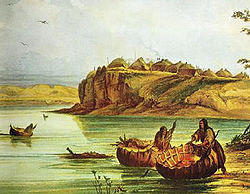
Bull Boat
Encyclopedia

Indigenous peoples of the Americas
The indigenous peoples of the Americas are the pre-Columbian inhabitants of North and South America, their descendants and other ethnic groups who are identified with those peoples. Indigenous peoples are known in Canada as Aboriginal peoples, and in the United States as Native Americans...
and frontiersmen, made by covering a skeletal wooden frame with a buffalo
American Bison
The American bison , also commonly known as the American buffalo, is a North American species of bison that once roamed the grasslands of North America in massive herds...
hide.
When traders of Hudson's Bay Company
Hudson's Bay Company
The Hudson's Bay Company , abbreviated HBC, or "The Bay" is the oldest commercial corporation in North America and one of the oldest in the world. A fur trading business for much of its existence, today Hudson's Bay Company owns and operates retail stores throughout Canada...
first visited the Mandan Indians in 1790 they found that tribe possessed of tublike boats with framework of willow poles, covered with raw buffalo
American Bison
The American bison , also commonly known as the American buffalo, is a North American species of bison that once roamed the grasslands of North America in massive herds...
hides. Later, frontiersmen who ascended the Missouri River
Missouri River
The Missouri River flows through the central United States, and is a tributary of the Mississippi River. It is the longest river in North America and drains the third largest area, though only the thirteenth largest by discharge. The Missouri's watershed encompasses most of the American Great...
noted this light, convenient craft. From 1810 to 1830, American fur traders on the tributaries of the Missouri regularly built boats eighteen to thirty feet long, using the methods of construction employed by the Indians in making their circular boats. These elongated bull boats were capable of transporting two tons of fur down the shallow waters of the Platte River
Platte River
The Platte River is a major river in the state of Nebraska and is about long. Measured to its farthest source via its tributary the North Platte River, it flows for over . The Platte River is a tributary of the Missouri River, which in turn is a tributary of the Mississippi River which flows to...
. These larger boats required joining the buffalo hides with waterproof seams, a technique not used by the American Indians.
A bull boat's framework was made of willow branches bent in a huge bowl shape about four feet across the top and eighteen inches deep. A bull buffalo hide (thus the bull phrase) was then stretched around this framework. The entire boat weighed about 30 pounds. The hair was left on the hide because it prevented the craft from spinning and aided in keeping the water out. The tails were also kept intact and used to tie numerous bull boats together. Once in the water, it was not very steady because it bobbed around like a cork, but it was serviceable for short trips.
William Clark of the Lewis and Clark Expedition
Lewis and Clark Expedition
The Lewis and Clark Expedition, or ″Corps of Discovery Expedition" was the first transcontinental expedition to the Pacific Coast by the United States. Commissioned by President Thomas Jefferson and led by two Virginia-born veterans of Indian wars in the Ohio Valley, Meriwether Lewis and William...
described them thus:
A bull boat is similar to a Welsh coracle
Coracle
The coracle is a small, lightweight boat of the sort traditionally used in Wales but also in parts of Western and South Western England, Ireland , and Scotland ; the word is also used of similar boats found in India, Vietnam, Iraq and Tibet...
or an Irish/Scottish currach
Currach
A Currach is a type of Irish boat with a wooden frame, over which animal skins or hides were once stretched, though now canvas is more usual. It is sometimes anglicised as "Curragh". The construction and design of the currach is unique to the west coasts of Ireland and Scotland, with variations in...
. This similarity was used to support a theory that a Welsh party
Madoc
Madoc or Madog ab Owain Gwynedd was, according to folklore, a Welsh prince who sailed to America in 1170, over three hundred years before Christopher Columbus's voyage in 1492. According to the story, he was a son of Owain Gwynedd who took to the sea to flee internecine violence at home...
colonized the New World in the 12th century. However, similar boats appear in many different regions and are not documented to share a common origin. In fact many of these boats appear to be similar solutions to common transportation needs for working on rivers.

